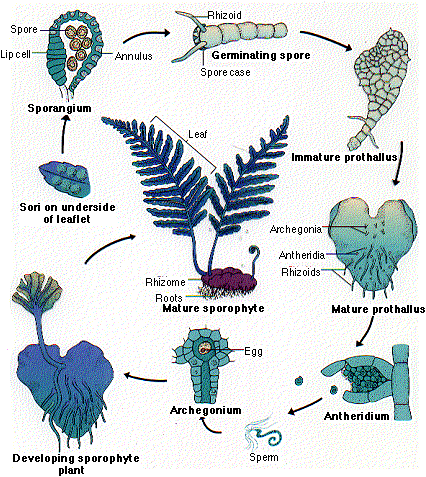Ferns
- About 9500 species
- Most are found in the tropics where tree ferns - with their above-ground stems - may grow as high as 40 feet.
- In temperate regions, the stems of ferns - called rhizomes - grow underground.
- The leaves - called fronds - grow up from the rhizome each spring.

Alternation of Generations
The Sporophyte Generation
The plant we recognize as a fern is the diploid sporophyte generation.
Sori form on the fronds. Each contains many sporangia mounted on stalks.
Within each sporangium, the spore mother cells undergo meiosis producing four haploid spores each.
When the humidity drops,
- The thin-walled lip cells of each sporangium separate.
- The annulus slowly straightens out.
- Then the annulus snaps forward expelling the spores.
If a spore is blown to a suitable moist location,
- It germinates into a filament of cells.
- This grows into a prothallus with
- rhizoids, which absorb water and minerals from the soil;
- archegonia, which produce a single egg (by mitosis);
- antheridia, which form swimming sperm (again, by mitosis).
Fertilization
If moisture is plentiful, the sperm swim to archegonia - usually on another prothallus because the two kinds of sex organs generally do not mature at the same time on a single prothallus.
Fertilization restores the diploid number and begins a new sporophyte generation.
The embryo sporophyte develops a foot that penetrates the tissue of the prothallus and enables the sporophyte to secure nourishment until it becomes self-sufficient.
Although it is tiny, the haploid fern prothallus is a fully-independent, autotrophic plant.
22 March 1999
